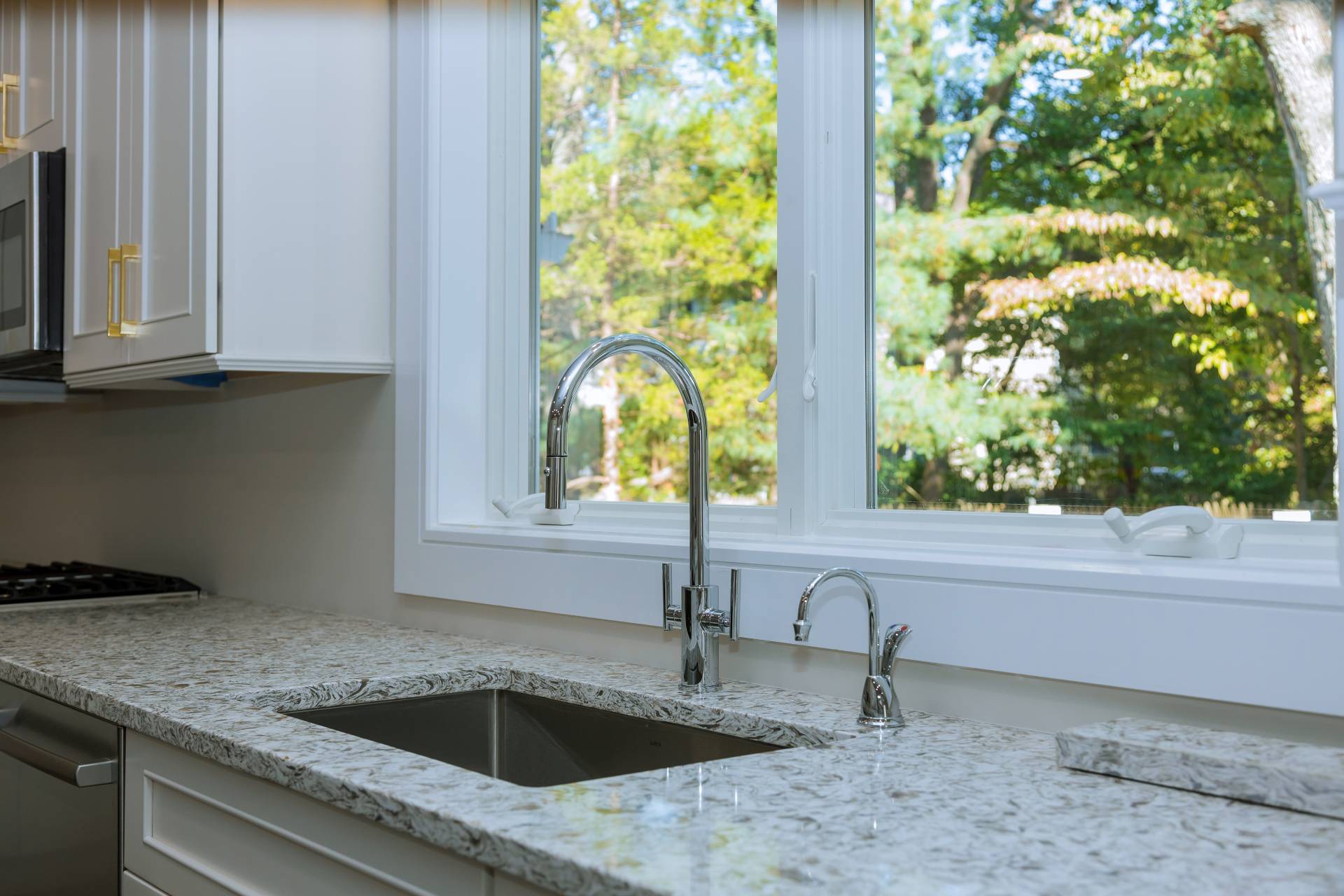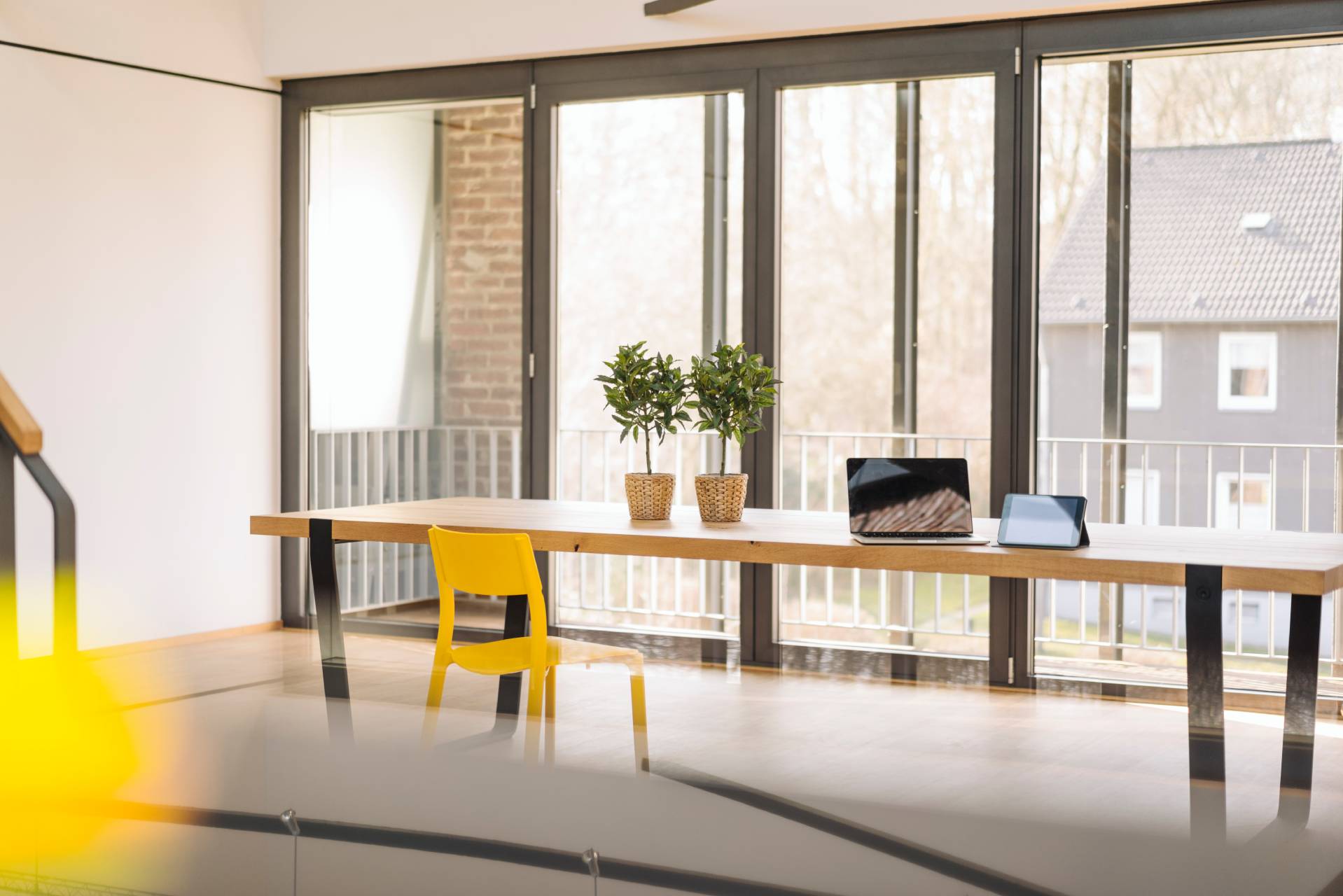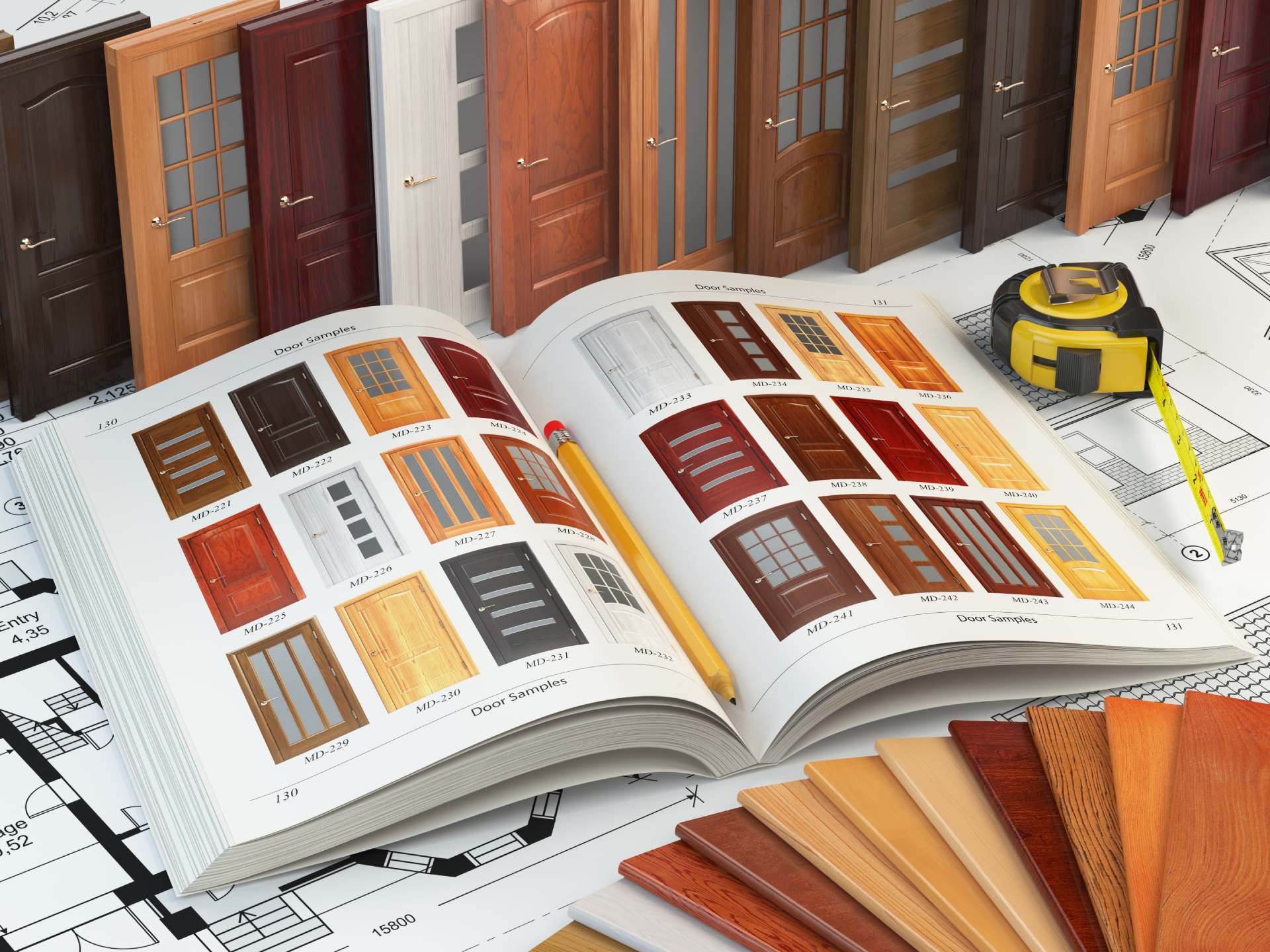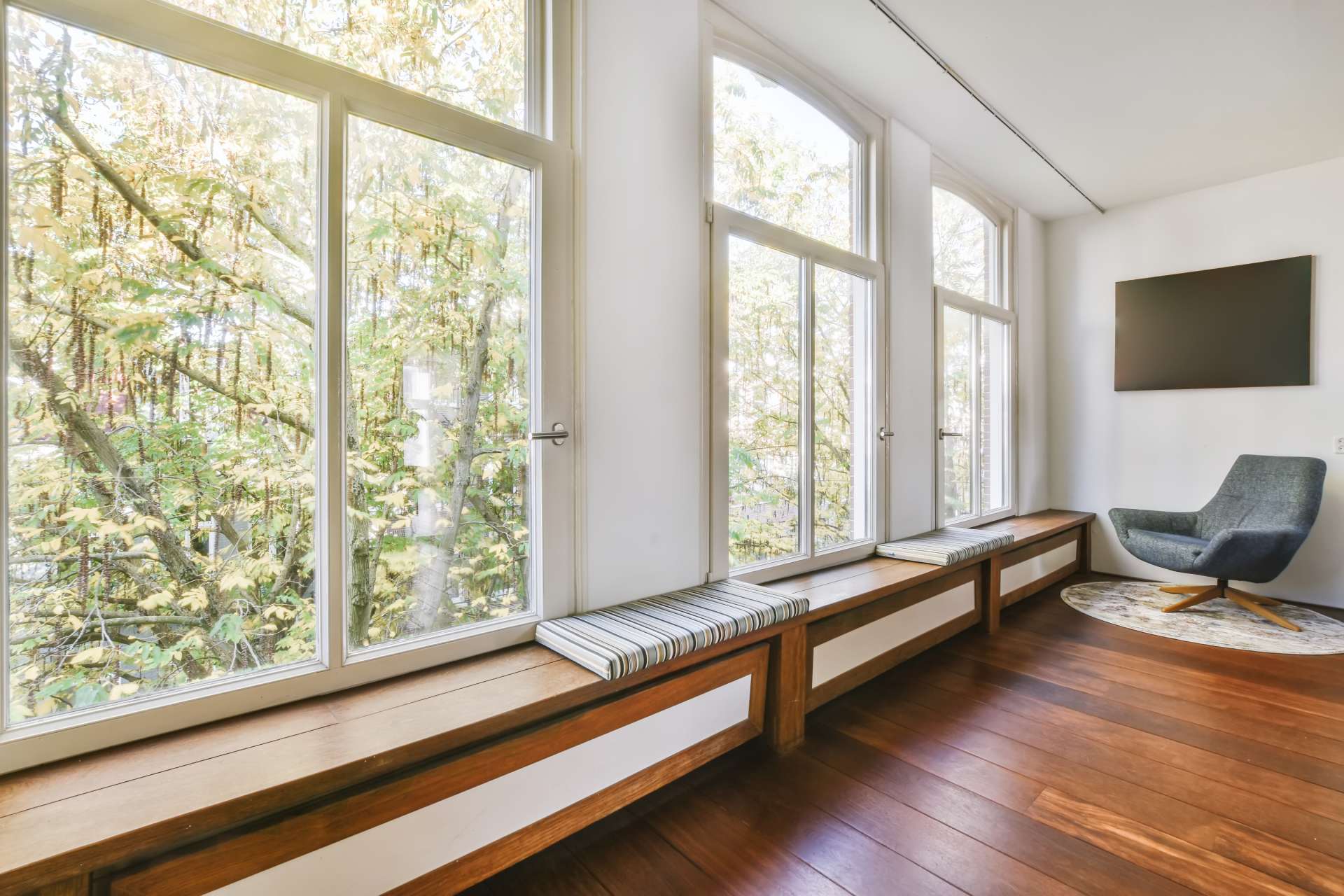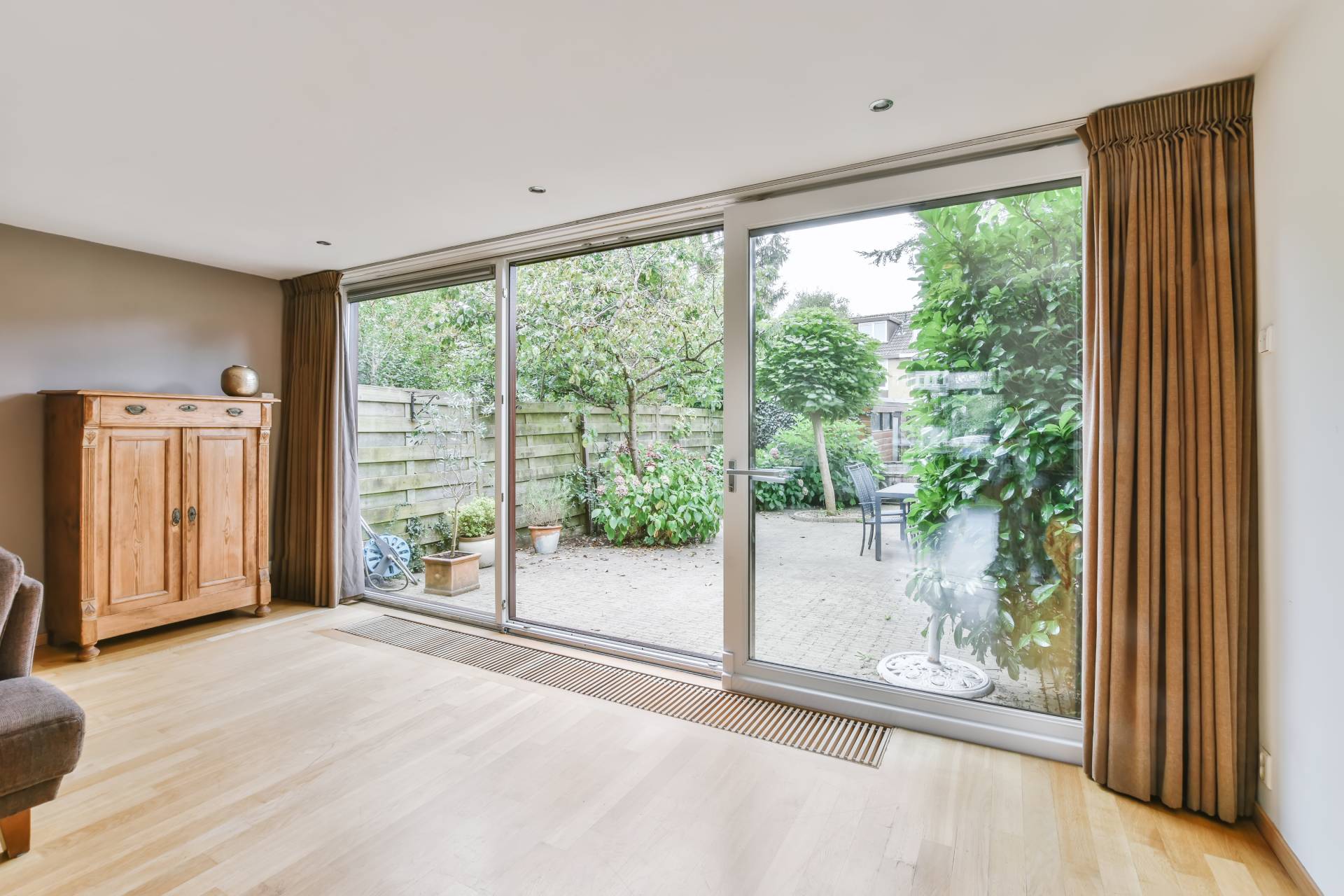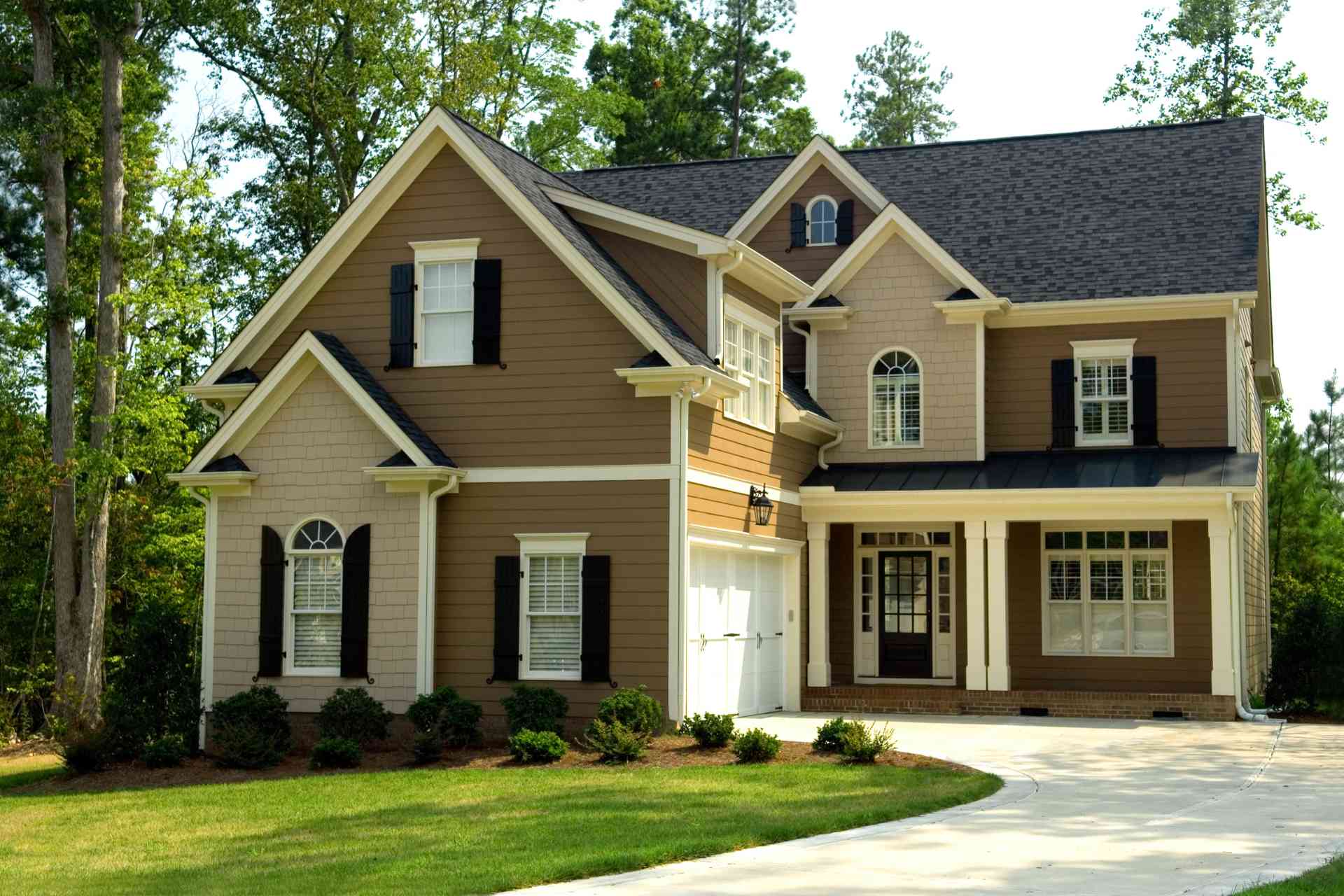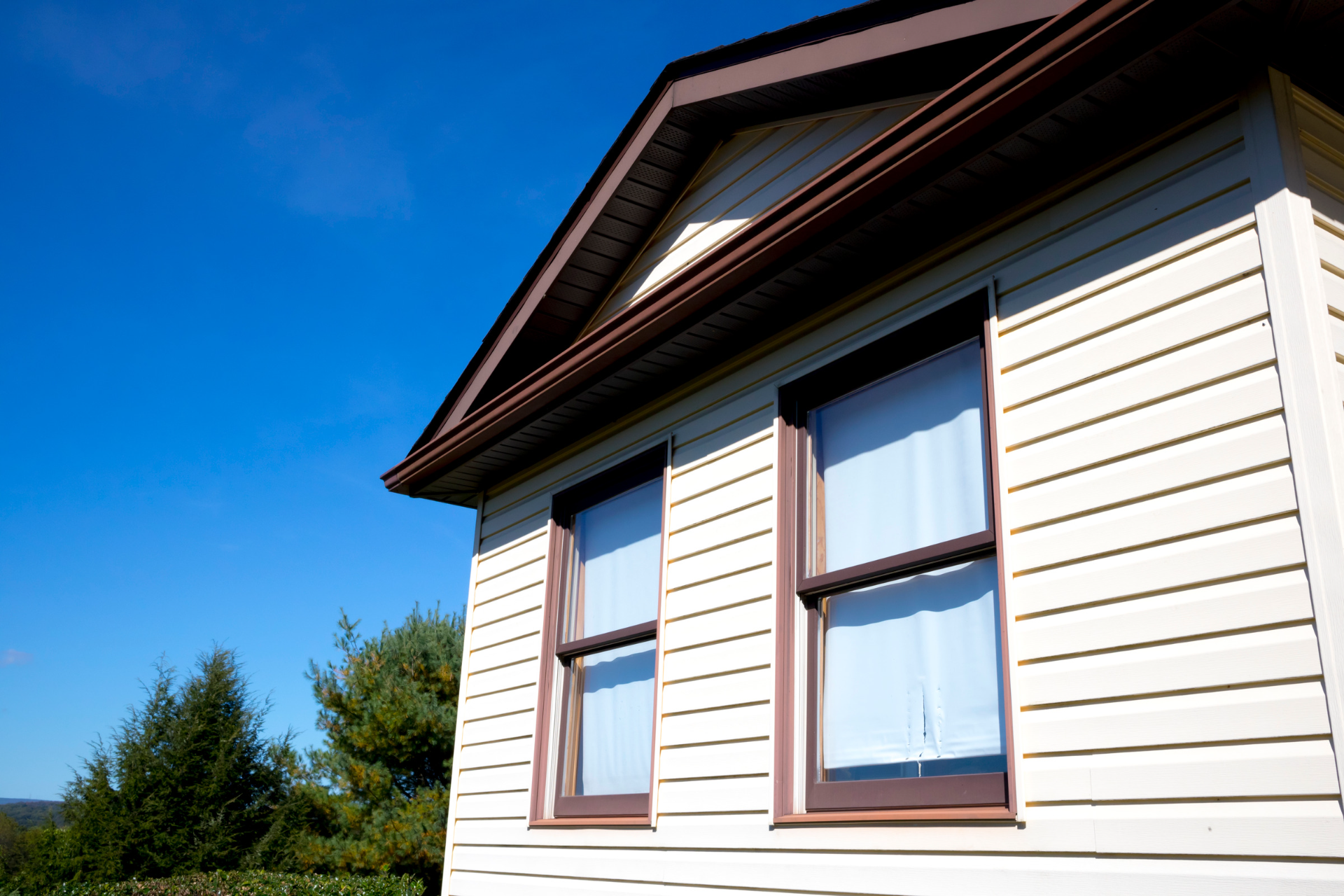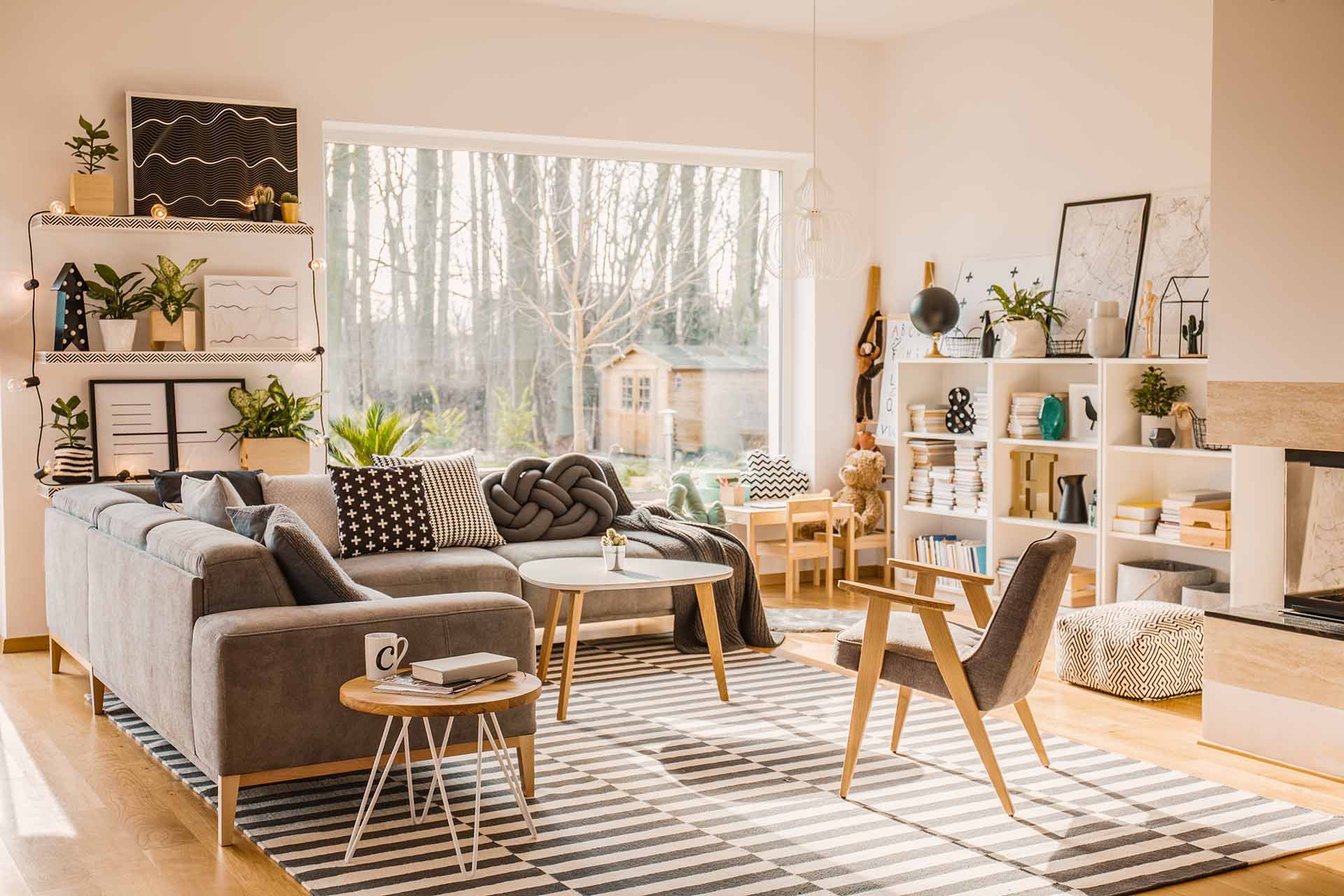Exploring the Top Window Styles for Maximizing Natural Illumination in Kitchens
A well-lit kitchen improves visibility, making tasks such as food preparation, cooking, and cleaning easier and safer. Natural sunlight creates a cheerful and uplifting atmosphere in the kitchen, making cooking and meal preparation more enjoyable.
Properly positioned windows and doors can ensure that light reaches key areas of the kitchen, such as the sink, countertops, and cooking surfaces. Placing a kitchen window over a sink is often considered best when maximizing natural light, providing task light, enjoying views and ventilation, and enhancing the aesthetics of the kitchen. This design choice combines functionality, practicality, and visual appeal to create a bright, beautiful, and functional kitchen space.
Here are the top window styles that can help you maximize natural lighting in the kitchen:
Casement Windows
Casement windows typically feature large glass panes that extend from the top to the bottom of the window frame. This expansive glass area allows ample light to enter the kitchen, brightening up the space throughout the day. Casement windows are hinged on one side and open outward with a crank mechanism. This design allows for versatile opening options, including fully opening the window to let in maximum sunlight or partially opening to control ventilation while still allowing natural light to enter. While primarily designed for ventilation, casement windows can also serve as effective sources of natural light. When closed, casement windows provide unobstructed views of the outdoors, allowing natural light to flood into the kitchen without any barriers. This clear view enhances the feeling of openness and connection to the outdoors, maximizing the perception of natural light in the space. Their large glass area and ability to fully open provide an optimal balance of ventilation and illumination in the kitchen.
Bay and Bow Windows
Bay and bow windows are excellent choices for maximizing natural light in the kitchen. Bay windows feature a larger central window flanked by two smaller side windows, with sharper angles and a more angular appearance. On the other hand, bow windows consist of multiple window panels arranged in a gentle curve along the exterior wall, creating a round or elliptical shape with a smoother, more uniform curve. Both bay and bow windows create an expansive glass area that allows plenty of natural light to enter the kitchen. The angled design of bay and bow windows allows natural light to enter the kitchen from multiple angles. This helps distribute sunlight evenly across the room, minimizing shadows and creating a well-lit environment. This configuration maximizes daylight exposure and brightens up the space throughout the day. Bay and bow windows provide panoramic views of the outdoors, allowing homeowners to enjoy the scenery while cooking or dining in the kitchen. The expansive views enhance the feeling of openness and connection to the outdoors, contributing to a bright and inviting atmosphere. In addition, bay and bow windows serve as architectural focal points that add character and visual interest to the kitchen. Their distinctive shapes and designs create a sense of elegance and sophistication, enhancing the overall appeal of the space.
Awning Windows
Awning windows are hinged at the top and open outward from the bottom, forming an awning-like shape when opened. While primarily designed for ventilation, awning windows also allow plenty of natural light to enter the kitchen even when closed. Their large glass area and upward-opening design provide an optimal balance of ventilation and illumination. With a crank mechanism or handle located at the bottom of the window frame, awning windows are easy to operate. This allows for smooth and effortless opening and closing, making it convenient to adjust ventilation and natural light levels in the kitchen. The outward-opening design of awning windows allows for ventilation without compromising privacy, as the window opens from the bottom and remains partially covered by the frame. Awning windows also provide protection from the rain when opened, allowing fresh air to circulate even during inclement weather. Additionally, awning windows have a sleek and modern appearance that complements contemporary kitchen designs. Their clean lines and minimalist aesthetic add a touch of sophistication to the space while maximizing natural light.
Picture Windows
Picture windows are typically large, fixed windows that consist of a single pane of glass. The absence of grids, muntins, or sashes maximizes daylight exposure and enhances the sense of openness and connection to the outdoors. Since picture windows do not open, they can be designed to cover a wide expanse of the exterior wall, capturing sunlight from multiple angles. This expansive glass area creates a panoramic effect that maximizes natural light distribution and brightens up the entire kitchen space. Picture windows come in various shapes and sizes, allowing homeowners to customize the design to suit their preferences and architectural style. Whether it is a large horizontal window above the sink or a floor-to-ceiling window overlooking the backyard, picture windows can be tailored to maximize natural light and enhance the overall aesthetics of the kitchen.
Overall, casement, bay, bow, awning, and picture windows are excellent choices for maximizing natural light in the kitchen. These window styles offer different features and benefits due to their large glass area, versatile opening options, expansive views, and architectural significance. Incorporating these window styles into the kitchen design can create a bright, airy, and inviting space illuminated by abundant natural light. Depending on the specific layout, design preferences, and architectural constraints of the kitchen space, homeowners can choose the window style that best suits their needs and enhances the overall brightness and ambiance of the room.
Understanding Energy Star Ratings for Windows: What You Need to Know
Energy efficient windows and doors can provide numerous benefits. They can help reduce energy bills, improve comfort, and increase environmental sustainability at home. Homeowners can easily identify energy efficient products by checking for the Energy Star label. These apply even to windows.
Here's what you need to know when selecting Energy Star-rated windows for your home:
Energy Efficiency Benefits
Energy Star-rated windows are designed to be more energy efficient than standard windows. These windows often feature advanced insulation technologies, such as multiple panes, low-emissivity (Low-E) coatings, and gas fills. The improved insulation provided by Energy Star-rated windows contribute to consistent indoor temperatures throughout the year. Homes with these windows often experience enhanced comfort in both hot and cold seasons. Using energy efficient windows helps reduce overall energy consumption, contributing to environmental sustainability. Homeowners can play a role in minimizing their carbon footprint by choosing Energy Star-rated products.
U-Factor and Solar Heat Gain Coefficient (SHGC) Values
Homeowners should be familiar with U-Factor and Solar Heat Gain Coefficient (SHGC) values when considering Energy Star-rated windows.
The U-Factor measures how well a window insulates and indicates the rate of heat transfer through the window. A lower U-Factor signifies better insulation. In colder climates, windows with a low U-Factor can help minimize heat loss and enhance energy efficiency. Windows with a higher U-Factor may allow more heat to escape, leading to increased heating costs.
SHGC measures the amount of solar heat that enters a home through the windows. A lower SHGC value indicates better control of solar heat gain. In warmer climates, or for windows receiving a lot of direct sunlight, homeowners may want windows with a lower SHGC to reduce the amount of solar heat entering the home. This helps in maintaining a comfortable indoor temperature and can lead to lower heating costs.
By looking for the Energy Star label, homeowners can easily identify Energy Star-rated windows. This label indicates that the windows meet or exceed the program’s energy efficient guidelines, including U-Factor and SHGC requirements.
Climate Zone Considerations
Energy Star criteria for windows vary based on different climate zones. Energy Star classifies climate zones into four categories: Northern, North-Central, South-Central, and Southern. These zones are based on regional climate conditions, such as temperature ranges and heating and cooling needs. Energy Star sets specific U-Factor and SHGC criteria for windows in each climate zone. The criteria are tailored to address the unique energy efficiency needs of homes in different climates. In colder climates (Northern and North-Central zones), where heating needs are higher, lower U-Factor values are recommended to minimize heat loss while SHGC requirements may be more flexible. In warmer climates (South-Central and Southern zones), U-Factor requirements may be less stringent while lower SHGC values are recommended to control solar heat gain and reduce the demand for air conditioning. Homeowners should consider the balance between U-Factor and SHGC based on their specific climate zones.
Long-Term Savings and Return on Investment
While Energy Star-rated windows may have a higher upfront cost compared to standard windows, homeowners should also consider the long-term savings in energy bills. Energy Star-rated windows contribute to lower heating and cooling costs. The enhanced energy efficiency helps reduce the demand for heating in winter and cooling in summer, leading to ongoing savings on utility bills.
As homeowners benefit from energy cost savings, they can realize a return on their investment over time. The duration from recouping the initial investment depends on factors such as energy prices, climate, and the specific characteristics of the windows. Furthermore, some regions offer incentives, rebates, or tax credits for energy efficient home improvements, including the installation of Energy Star-rated windows. Checking with local utility companies or government programs can help in exploring potential financial benefits.
Energy Star-rated windows are typically designed for durability and longevity. Proper maintenance of Energy Star-rated windows ensures their continued energy efficiency. Regular cleaning, inspection, and repairs, if needed, contribute to the windows’ longevity and overall performance. Choosing high-quality windows can result in a longer lifespan, providing extended opportunities for energy savings over the years.
Energy efficient upgrades can enhance the resale value of a home. Potential homeowners who recognize eco-friendly practices can appreciate the positive environmental impact of using Energy Star-rated products. Potential buyers may also be attracted to the prospect of lower energy bills and a more comfortable living environment, making the property more marketable.
If you are looking for energy efficient windows and doors, look for the Energy Star label on the products. The label indicates that the windows or doors have undergone testing and meet or exceed the energy efficiency standards set by the Energy Star program. When selecting windows and doors for your home, it is advisable to consult with a professional who can provide guidance on selecting windows that suit your home’s local climate and your energy efficiency goals.
The Latest in Bedroom Window Styles for 2024
Creating a visually appealing and comfortable environment is important for bedrooms. A well-designed and aesthetically pleasing bedroom promotes a sense of comfort and relaxation. Thoughtfully chosen colors, textures, furnishings, and fixtures can create a cozy and inviting atmosphere that encourages rest and rejuvenation. Windows and doors play a crucial role in the overall functionality, comfort, and aesthetic of a bedroom. The choice of door and window style, material, and finish can enhance the room’s design and complement its interior décor.
For 2024, here are window styles that can enhance the aesthetics and functionality of your bedroom:
Large Windows
This coming year, connection to nature is an important aspect of bedroom style. Sustainable and environmentally friendly themes and practices have become part of many lifestyles. Fashionable bedroom décor includes houseplants, earthy tones, and sustainable materials.
Large windows provide fantastic views of the surrounding environment, such as a garden or natural landscape. With large windows, the boundaries between indoor and outdoor spaces become less distinct. Large windows can enhance the overall visual appeal of the bedroom and create a sense of connection to the outdoors. This connection to nature can create a calming and peaceful atmosphere, promoting relaxation and stress reduction.
Bedrooms with large windows are awesome. Large windows allow a significant amount of natural light to enter the room, creating a bright and airy atmosphere. Exposure to natural light is known to have positive effects on mood, energy levels, and overall wellbeing. The abundance of natural light and the connection to the outdoors can create an illusion of a large and more open space. This can be particularly beneficial in smaller bedrooms, making them feel more spacious. Large windows can also facilitate better ventilation by allowing more fresh air to circulate through the room. This can maintain a comfortable indoor environment and prevent the room from feeling stuffy.
Large windows can be a focal point of the bedroom’s design, adding a sense of grandeur and sophistication. They can also be a key element in the overall architecture of the room.
Bay Windows
The need for storage space is one that never goes away. This coming year, bay windows with built-in seats and storage are a stylish way to blend functionality and aesthetics. Bay windows are a type of window design that projects outward from the main wall of the room, creating a bay or alcove in the interior. Bay windows add architectural interest to a room, creating a visually appealing focal point. The combination of a bay window, seat, and storage can add charm and character to the bedroom, enhancing its overall aesthetics.
Bay windows typically have multiple panels of glass, allowing ample natural light to flood the space. This can make the bedroom feel brighter, airier, and more inviting. A bay window with a seat and storage is a multi-functional design element. It serves not only as a source of natural light and a seating area but also as a practical storage solution. The seat in the bay window creates a perfect spot for a perfect reading nook. Placing a cushion or pillows on the seat can make it a comfortable space to enjoy the sunlight and to relax. The area beneath the bay window seat can be utilized for storage. This additional storage space is valuable for keeping the bedroom organized and clutter-free. The versatility of a bay window with seating and storage maximizes the use of available space.
The design of bay windows often includes a wide and unobstructed view of the surroundings. This can be advantageous if the bedroom is in a location with scenic views, such as a garden, cityscape, or natural landscape. The expansive view can foster a connection with nature, which is a key aspect in bedroom styles for 2024.
Casement Windows
For 2024, minimalist designs and classic modern styles are in vogue. The clean lines and modern design of casement windows can contribute to the overall architectural aesthetics of a bedroom. They can complement various styles and add a touch of elegance to the room.
Casement windows typically have large glass panes that allow ample natural light to enter the room. They are hinged on one side and open outward like a door. This design allows for maximum ventilation, as the entire window can be opened to let in fresh air. The unobstructed view and the ability to fully open the window can contribute to a comfortable and healthy environment. Casement windows provide unobstructed views because there is not vertical middle bar on the window. This enhances the bedroom’s connection to the outdoors, as it allows for a clear and expansive view.
Casement windows come in various sizes and shapes, offering versatility in design. Homeowners can choose from a range of styles and customize the windows to match the aesthetic of the bedroom. Recently, custom or handmade design elements have gained momentum, and they are expected to stay in style for 2024. The casement window’s flexibility in design allows for creative and personalized window configurations.
When choosing windows for a bedroom, it is important to consider factors such as the size of the room, the desired level of natural light and ventilation, and the overall aesthetic preferences. Working with professionals can help ensure that the chosen windows meet your functional and design requirements.
5 Essential Considerations Before Upgrading Your Windows & Doors
Windows and doors play a crucial role in safeguarding our homes, ensuring our security, and even boosting our home's overall appeal. But, like everything else, they age and wear out. That's when the idea of upgrading your windows and doors becomes a top priority. We're here to guide you through five key considerations before you embark on this exciting home improvement journey.
1. Do I Need an Upgrade?
Before you leap into upgrading your windows and doors, let's take a moment to think about your unique needs. This isn't about blindly following trends; it's about ensuring your investment aligns with what you truly need.
One significant consideration is energy efficiency. Those old windows and doors might be quietly siphoning away your hard-earned cash through sneaky drafts. Upgrading can lead to substantial savings on your energy bills down the road. Imagine a cozier home and a fatter wallet – that's the dream!
Of course, your safety and the safety of your loved ones are paramount. Outdated windows and doors might not provide the same level of security that modern options do. Upgrading can offer peace of mind, knowing your home is better protected against unwanted guests.
Finally, the looks of your house are as important as the other needs you have to consider. Aside from your personal satisfaction, a good-looking house can have a substantial impact on your home's resale value. New windows and doors can work wonders for your house's curb appeal, making it more inviting to guests and potential buyers.
To make your decision-making process smoother, try jotting down what you hope to achieve with this upgrade. Are you mainly focused on slashing those energy bills, beefing up security, or giving your home a fresh new look? Knowing your objectives will be your trusty guide throughout this journey.
2. Can I Afford to Upgrade My Windows and Doors?
Now, let's dive into the financial aspect of this home improvement journey – a topic that's crucial for any project. Upgrading your windows and doors is indeed an investment that can boost your home's value, but it's vital to have your finances in order.
Getting yourself a clear budget is necessary if you want this to be a successful project. It'll prevent you from overspending and ensure you have enough funds to continue the project until its completion. So, take time to look at your financial position and see whether an upgrade is something you can afford at the moment.
It's also good to remember that the overall cost of the project can vary due to different factors. A good example of this is the materials that will be used for the upgrade. Aside from the upfront cost of different materials, their unique features might call for specific installation techniques that will take more time and money. It's really best to gather as many quotes as you can before proceeding. Having a financial strategy will ensure that you get the upgrade you deserve.
3. What Materials To Use?
Not that you have the budget, the next step is choosing the right materials. Materials for windows and doors include wood, vinyl, and aluminum. Each material comes with its own distinct set of benefits and drawbacks, so it's of utmost importance to choose the one that best suits your particular requirements.
Wooden windows and doors offer classic beauty, but they demand regular upkeep to prevent rot and decay. Vinyl, on the other hand, is virtually maintenance-free and excels in energy efficiency. Aluminum is durable and modern but might not provide the same insulation as other materials.
Your local climate plays a significant role in your material selection. In harsh weather conditions, more robust materials like fibreglass might be a better fit. Also, consider your personal preferences. Do you lean toward the timeless appeal of wood or the modern simplicity of aluminum? Finding the right balance between aesthetics and functionality is key.
4. Can I Maintain My New Windows and Doors?
Maintaining your new windows and doors is an often overlooked aspect of ownership. Different materials have distinct maintenance needs, so let's shed some light on this topic.
Wood: Wooden windows and doors require periodic painting or staining to shield them from the elements. Neglecting this can lead to rot and decay. If you're ready to commit to this upkeep, wood can be a beautiful choice.
Vinyl: Vinyl is incredibly low-maintenance. It mainly needs occasional cleaning with soap and water to keep it looking pristine. For busy homeowners, vinyl offers the benefit of time-saving maintenance.
Aluminum: Aluminum is durable and generally resistant to rust and corrosion. Regular cleaning is typically all that's needed to maintain its appearance.
Proper maintenance not only keeps your windows and doors looking good but also extends their lifespan. Consider your lifestyle and how much time you can realistically dedicate to maintenance when choosing your materials.
5. Who Should I Ask For Help?
Finally, let's emphasize the importance of professionals in this upgrade process.
Installing windows and doors is more than just swapping out old for new. It involves precise measurements, structural considerations, and ensuring a snug fit to prevent drafts. Improper installation can lead to problems down the line, such as leaks and decreased energy efficiency.
So, the wisest decision you can make is to get a professional contractor to do the job. Their expertise and hands-on experience will ensure that the job is completed correctly from the get-go. While DIY projects can be fulfilling, when it comes to windows and doors, which are an investment in your home's comfort and value, professionals truly excel in delivering top-notch results.
The Risks of Not Taking These Into Consideration
We understand that the prospect of an upgrade can be quite thrilling, but neglecting the considerations we've outlined can have more downsides than upsides. For instance, not having a suitable budget may tempt you to cut corners, leading to an incomplete and unsatisfactory project. Likewise, attempting a full DIY approach without the necessary tools and expertise might result in windows and doors that don't harmonize with your home's aesthetics. Moreover, a poorly executed project can create security vulnerabilities, putting your loved ones at risk. Rushing into it could potentially leave you in a worse position than before you even initiated the upgrade.
Conclusion
Upgrading your windows and doors is a significant decision that can enhance your home's aesthetics, energy efficiency, and security. By considering your specific needs, budget, materials, maintenance, and the importance of professional help, you can embark on this home improvement journey with confidence. Take your time, make informed decisions, and watch as your home transforms into a more comfortable and beautiful space.
5 Advantages Of Triple Pane Windows
In the world of windows and doors, triple-pane windows are gaining popularity. These windows aren't just a passing trend. They're here to revolutionize the way we experience our homes. We're about to delve into the fantastic advantages that triple-pane windows bring to the table, so buckle up for a journey into the realm of enhanced comfort and efficiency.
Understanding Triple Pane Windows: Elevating Insulation and Comfort
Triple-pane windows are more than just your regular glass panels; they're like a cozy fortress for your home. Imagine three layers of glass stacked together, forming a robust trio between you and the elements. But that's not all – between these layers are air or gas-filled chambers that elevate their insulation game to a whole new level.
The construction of triple-pane windows involves more than just slapping together three layers of glass. The design of these windows optimizes insulation and performance.
High-Quality Glass: Each of the three glass panes is made from high-quality materials engineered to provide durability, clarity, and energy efficiency.
Spacer Systems: The layers of glass are separated by spacer systems, which maintain consistent spacing between the panes. These spacers are energy-efficient and often contain desiccants that prevent condensation and moisture buildup between the layers.
Gas Filling: If the chambers between the glass layers are filled with gas, such as argon or krypton, it's not just to sound fancy. These gases are denser than air, which reduces heat conduction, adding another layer of insulation.
A Deep Dive on Triple-pane Window Advantage:
Superior Insulation: Keeping Comfort In and Extreme Temperatures Out
The secret to triple pane windows' exceptional insulation lies in their layered design. Think of them as the cozy sweater your home wears to combat extreme temperatures. With three layers of glass and those nifty air pockets, these windows create a barrier that keeps indoor warmth during winter and outdoor heat during summer right where they belong. Say goodbye to those icy drafts and sweltering afternoons.
The magic of these windows can be seen right on your energy bill. With less heat escaping in winter and less heat infiltrating in summer, your heating and cooling systems can take a breather. That's right – lower energy consumption means lower bills, making your wallet and the environment smile.
Energy Efficiency Galore: Saving Money and the Environment
You might be wondering, how exactly does insulation connect with energy efficiency? This principle behind it is actually quite simple. When triple-pane windows properly insulate your home, you'll have more stable indoor temperatures. And stable temperatures mean your heating and cooling systems don't need to go the extra mile to keep your indoor climate cozy. This characteristic translates to using less energy, resulting in clear-cut savings on your utility bills.
But the ripple effect extends beyond your financial gain. As you trim down your energy consumption, you play a part in environmental stewardship. It's a modest adjustment that, when joined by others, creates a substantial impact by shrinking your carbon footprint and contributing to a greener tomorrow.
Noise Reduction: Creating a Tranquil Indoor Haven
Living near bustling streets or rowdy neighbours? Triple-pane windows are your new best friend. The added layers of glass serve as noise buffers, intercepting and muffling external sounds. Those air-filled chambers? They're like your personal soundproofing assistants, ensuring that traffic and commotion stay where they belong – outside.
Imagine enjoying a serene living space without the intrusion of honks and shouts. Triple-pane windows bring peace, turning your home into a sanctuary away from the noise of the outside world.
UV Protection: Shielding Your Home and Health
The sun is wonderful, but its UV rays? Not so much. Triple-pane windows guard your home and health against these harmful rays. You see, these UV rays can wreak havoc on your furniture, flooring, and even your well-being. Those UV-blocking coatings in triple pane windows act as shields, keeping the harmful rays at bay.
These coatings aren't just about keeping your décor's colours vibrant; they're also a shield for your family against potential health hazards linked to prolonged UV exposure. It's like gifting your home a chic pair of sunglasses that genuinely care for your well-being.
Enhanced Security: Defending Your Home with an Extra Layer
When it comes to safeguarding your home, triple-pane windows have your back. The additional layer of glass serves as a formidable obstacle against potential intruders. Imagine attempting to breach not one, not two, but three layers of glass. It's a challenge that's more than sufficient to discourage even the most resolute wrongdoers.
This extra layer of protection grants you the peace of mind you deserve. You'll sleep better at night knowing your home has an added defence against unwelcome visitors.
Considerations and Costs
Of course, as with any upgrade, there are factors to consider. Triple-pane windows might involve a higher initial cost, but remember you're investing in long-term benefits. Think of it as putting money into a cozier, quieter, and more efficient future. Additionally, when opting for installation, choose reputable professionals to ensure the windows perform their best.
Maintenance Considerations: Keeping Your Investment in Prime Condition
Maintaining your triple-pane windows isn't a complicated task. So, here are some tips to ensure their long-term performance:
Regular Cleaning:
Just like any windows, triple-pane windows benefit from regular cleaning. Use a mild soap and water solution to clean the glass and frames. But avoid abrasive materials that could scratch the glass.
Inspect Seals and Weatherstripping:
Periodically inspect the seals and weatherstripping around your windows. If you notice any gaps or deterioration, address them promptly to maintain the windows' energy efficiency.
Condensation Management:
While manufacturers designed triple-pane windows to reduce condensation, monitoring moisture levels is still a good idea, especially during extreme temperature changes. Use proper ventilation to manage indoor humidity.
Hardware Check:
Check the operation of handles, locks, and hinges. Lubricate moving parts if needed to ensure smooth operation.
Conclusion: Elevate Your Home's Comfort and Efficiency
To sum it all up, triple-pane windows are like the superheroes of the windows and doors world. They bring exceptional insulation, energy savings, noise reduction, UV protection, and enhanced security to your home. While the initial costs and installation considerations might raise an eyebrow, the long-term benefits speak for themselves.
So, if you're prepared to turn your home into a snug and efficient sanctuary, take a closer look at the perks of triple-pane windows. This upgrade could very well be the solution that opens the door to a fresh realm of comfort and well-being for both you and your cherished ones.
Outdoor Spaces: Enhancing Your Patio with Sliding Doors and Large Windows
Outdoor patios provide accessible spaces to connect with nature. From the comfort of your own home, you can experience the changing seasons, enjoy fresh air, and soak in natural sunlight. With outdoor patios, you can relax or unwind or host social gatherings. Whether you have a garden or landscaping or have added accents and décor, your outdoor patio serves as a visually appealing focal point that contributes to your home’s overall curb appeal. A well-designed outdoor patio can harmoniously blend with the architectural style of your home. It serves as an extension of your home’s living space, adding functional value as well.
Windows and doors connect your home’s interior and exterior areas. If your home has an outdoor patio, sliding doors and large windows can improve your experience and enhance your home’s aesthetic. Here are some ways they do:
Indoor-Outdoor Flow
Providing unobstructed views of the outdoors, sliding doors and large windows can blur the boundaries between your indoor living space and the patio. When open, the sliding doors remove physical barriers between your indoor space and your outdoor patio. This creates a more fluid flow between the two spaces. With sliding doors, it is easy to move between your home’s indoor and outdoor areas, making your patio feel like an extension of your home. Enhancing the indoor-outdoor flow of your home can encourage you to incorporate outdoor living into your daily routines, such as using the patio for morning coffee, afternoon work, or evening relaxation. The seamless integration and flow between these spaces can help you feel less cooped up at home and more connected to the outdoors, positively impacting your overall wellbeing.
Expansive Views
Large windows and sliding doors often feature wide floor-to-ceiling glass panels and minimal frames, which minimize the visual barriers between the indoors and outdoors and offer expansive views of your outdoor patio and its surroundings. Large windows and doors can provide panoramic sightlines that capture the entirety of your patio area, enhancing the sense of openness and connection to the outdoor environment. When strategically placed, large windows and sliding doors can frame specific aspects of your patio, garden, or landscape, creating a visually pleasing focal point that draws the eye. Fully opening sliding doors can create a visual extension from your indoor space to your patio, making your patio feel like an integrated part of your living area.
Abundant Natural Light
With wide glass panels of large windows and sliding doors, more sunlight can enter your home from various angles throughout the day. This means that you will not need to rely on artificial lighting to create a bright and comfortable environment in your living spaces. Natural light creates a comfortable ambiance and helps make your living spaces feel comfortable and welcoming. As the sun changes positions throughout the day, you can enjoy the dynamic aesthetic created by the play of light and shadows at different times of the day. Sliding doors and large windows can significantly increase the overall brightness and visual appeal of your home and reinforce your connection to the outdoor environment.
Seamless Entertaining
Sliding doors can create a harmonious environment for social gatherings. By keeping sliding doors open, you can allow guests to easily move between your home’s indoor and outdoor spaces. Making your outdoor patio accessible allows for an expanded gathering space and avoids overcrowding in your indoor spaces. Furthermore, with the option to open or close sliding doors, you can have the flexibility in arranging dining and entertainment areas. You can opt to serve food indoors and then dine outdoors. You can also adjust the layout to suit different stages of your event or gathering, such as an outdoor cocktail hour followed by an indoor dinner. Having the option to move between indoor and outdoor spaces can make hosting more enjoyable and efficient. It can also keep guests connected and engaged, whether they are indoors or outdoors. In some cases, such as changing weather conditions, easy access to the indoor spaces can ensure your guests’ comfort and overall enjoyment.
Aesthetic Integration
From both the exterior and the interior, the design of large windows and sliding doors can complement the architectural design of your home. The glass surfaces of the windows and doors can reflect outdoor elements, such as the landscaping, and create an illusion of expanded space as you look at your home from your outdoor patio. The use of large windows and sliding doors can encourage you to treat your patio as an extension of your indoor living space and inspire you to decorate it with furnishings and accessories that match your indoor décor. Large windows and sliding doors act as frames that showcase the outdoor environment. They let you appreciate the design of your patio and turn the view of your patio and its surroundings into a captivating design feature of your home.
When incorporating large windows and sliding doors as design elements for your outdoor patio, be sure to consider the orientation of your home, the location of key views, the placement of furniture, and the landscaping and layout of your patio space. With these in mind, you can design a beautiful and functional patio that complements your home’s overall aesthetic.
5 Maintenance Hacks to Keep Your Windows Looking Sharp this Spring
Spring is the ideal season to revitalize your home, and one area that is sometimes forgotten is the upkeep of your windows and doors. Since windows serve as entrances to the outside world, they require special attention to keep them appearing crisp and appealing. There are a variety of maintenance hacks and practical ideas to keep your windows and doors in beautiful condition during the spring season. You can enjoy the beauty and usefulness of your windows and doors while enjoying the invigorating spirit of spring with a little effort and these helpful tips.
1. Setting up and gathering supplies
Spring is a time for regeneration and new beginnings, and what better way to celebrate than by refreshing your windows? The first step is to get your windows ready for the season. Decluttering the area surrounding your windows creates a clean and open place for simple access and thorough inspection. Remove any plants, furniture, or other impediments to your cleaning operation. This not only simplifies your efforts but also creates a calm setting in which your windows can truly shine.
After you have decluttered your room, it's time to assemble your cleaning items. When it comes to window cleaning, it is essential to choose a mild and effective window cleaner. Gather the required instruments to provide a complete and flawless cleaning. A microfiber cloth is ideal for wiping away dirt and grime without leaving streaks or lint. Keeping a squeegee on hand for a smooth and quick cleaning is also a good idea, especially on bigger windows. A soft-bristle brush can also be useful for removing stubborn stains or reaching into corners. Finally, a vacuum cleaner with a brush attachment is essential for eliminating loose dirt and dust from the sills and frames, guaranteeing a comprehensive and precise cleaning operation.
2. Streak-free windows
When it comes to preserving the attractiveness of your home, having immaculate, streak-free windows is the ultimate goal. To get started, timing is important, choose an overcast day or a period when the sun is not shining directly on your windows. Direct sunlight could lead to the cleaning solution drying too rapidly, leaving ugly stains behind. Cleaning on a cloudy day allows the cleaner to operate without hindrance from the sun's beams. When it comes time to clean your windows, use a simple yet efficient method. On one side of the pane, use vertical strokes and horizontal strokes. This procedure makes it simple to identify and remove any streaks that may occur, resulting in a faultless finish. Remember to use a light touch and even pressure as you make your way across the glass. Choosing the appropriate equipment may make all the difference when it comes to streak-free windows. For best results, use a high-quality microfiber cloth or a rubber-edged squeegee. These products are particularly intended to reduce streaking, so your windows dazzle and sparkle in the bright spring sunlight.
3. Reviving window frames and sills
It is imperative to provide equal care to the window frames and sills when it comes to preserving the overall appearance and functioning of your windows. Fortunately, with a little care and effort, you can simply restore your window frames and sills to like-new condition. Remove any loose dirt and debris before beginning the process of rejuvenating your window frames and sills. Begin by gently sucking away any collected dust or grime from the surfaces using a vacuum cleaner equipped with a brush attachment. This first process can help in preventing dirt from spreading throughout the cleaning process. After the loose dirt has been removed, use a gentle cleaning solution with mild soap and water. In a bucket or container, combine a tiny amount of mild soap with water, making sure the solution is not too concentrated. Dip a soft cloth or sponge into the soapy water and wring it out to remove any excess liquid. Then, apply the soapy solution carefully to the window frames and sills, being sure to thoroughly cover all surfaces.
Scrub away any stains or markings that may have developed on the frames and sills with the soapy solution. It is important to rinse the soapy residue from the frames and sills after scrubbing. To fully rinse away the soap, use a clean cloth or sponge wet with clean water. Check that all of the soap has been gone, since any leftover residue may collect dust and debris, rendering your efforts unproductive. After the frames and sills have been washed, thoroughly dry them. Wipe away any extra wet with a clean, dry towel to avoid water damage. Pay special care to the edges and corners, where water tends to collect. Keeping the frames and sills totally dry will assist to maintain their structural integrity and prevent any possible moisture concerns.
4. Tackling window screens and tracks
Window screens and tracks are essential for keeping your windows clean, functional, and visually appealing. These regions can gather dirt, dust, and even bugs over time, impeding their smooth operation and detracting from the overall beauty of your windows. However, by including a few basic steps into your window care routine, you can keep both the screens and the tracks in excellent shape. Begin with the window screens. To start with, carefully remove them from the windows, being careful not to harm the delicate mesh. After you have removed the screens, you can thoroughly clean them. In a bucket or sink, combine warm water and mild soap. Clean them carefully with a soft brush or sponge. Pay careful attention to the corners and edges, which tend to collect dirt and debris. Thoroughly rinse the screens to eliminate any traces of soap, ensuring they are clean and residue-free. Finally, allow the screens to fully dry before reinstalling them on the windows.
Moving on to the window tracks, it's essential to remove any loose dirt or debris that has collected over time. This may be accomplished by gently sweeping away the debris with a vacuum cleaner equipped with a brush attachment or a tiny brush. Clean thoroughly, ensuring that all nooks and crevices are clear of dirt. It may be beneficial to lubricate the tracks of your windows to guarantee smooth operation. To clean the tracks, use a silicone-based spray or a thin application of petroleum jelly. These lubricants will minimize friction and make it easier to open and close the windows. Sparingly apply the lubricant, concentrating on the regions where the window slides down the tracks. Wipe away any excess lubrication to prevent dirt and dust from adhering to it.
5. Make maintenance and inspections a routine
When it comes to window maintenance, more than mere appeal is at risk. Regular maintenance is critical to the lifespan of your windows and may save you the trouble and expense of repairs or replacements. You can keep your windows in good condition and enjoy their benefits for years to come by adding a few of the mentioned practices into your routine. Cleaning your windows at least twice a year, preferably in the spring and fall, is an essential practice. In addition to regular cleaning, it is essential to examine your windows on a regular basis for signs of wear or damage. Keep a look out for cracked or chipped glass, damaged seals, or faulty gear. These flaws can jeopardize the performance of your windows and perhaps lead to energy inefficiency or security threats. You can avoid more damage by correcting these issues as soon as possible.
As spring approaches, with its promise of new beginnings, now is the time to focus on the upkeep of your windows and doors. You can keep your windows looking crisp by using the maintenance hacks and techniques mentioned, welcoming plentiful natural light into your room, and increasing the overall aesthetics of your home. Embrace the spirit of spring, put in a little time and work, and enjoy the clean, lively atmosphere that well-maintained windows and doors provide to your home.
The Pros & Cons of Installing Vinyl Windows and Doors (and Why They're More Popular Than Ever)
Windows and doors are critical components of our home's functionality, appeal, and energy efficiency. With so many options, vinyl has emerged as a popular alternative for homeowners looking for a long-lasting and adaptable solution. In this article, we will look at the benefits and drawbacks of vinyl windows and doors, as well as why they have become so popular in the home remodeling business. With a better understanding of what makes vinyl so good, you can make an informed choice about the best alternatives for your windows and doors, whether you are planning a remodel or building a new home.
Pro: aesthetics and versatility in design
Vinyl windows and doors have become a popular choice among homeowners due to its practicality as well as their outstanding visual appeal. Vinyl's ability to simulate the look of wood or metal is quite impressive. Whether you want the warmth and charm of real wood or the sleek and sophisticated look of metal, vinyl can accurately replicate these textures and finishes. The best aspect is that vinyl windows and doors maintain their immaculate appearance without requiring substantial maintenance. Unlike wood, which needs to be painted, stained, and sealed on a regular basis to keep its beauty, vinyl's colors and finishes are made to last, resisting fading and degradation over time. This means your vinyl windows and doors will continue to improve your home's curb appeal for years to come, making it an ideal investment for any home.
Another benefit of vinyl windows and doors is their excellent design adaptability. Vinyl can be readily customized to fit any window or door opening, making it an excellent solution for homes with unique architectural characteristics. Whether you envision wide bay windows that flood your living area with natural light or exquisite bow windows that lend a touch of elegance to the exterior of your home, vinyl can be curved and molded to make your vision a reality. Furthermore, vinyl is an excellent choice for sliding doors, providing smooth and effortless operation while retaining vinyl's energy efficiency and durability. The options are nearly unlimited, allowing you to personalize your living areas and create a really special environment that represents your style and personality.
Pro: low maintenance
When it comes to window and door care, vinyl truly shines as a hassle-free and low-maintenance alternative. Vinyl's extraordinary resistance to scratches, dents, and fading is one of its most notable characteristics. This means that your vinyl windows and doors will retain their gorgeous and vivid appearance even after years of use without displaying signs of wear and tear. The color and finish of vinyl are preserved, bringing a touch of elegance and refinement to the exterior as well as the interior of your home.
Cleaning vinyl windows and doors is a snap, adding to the ease and simplicity of their upkeep. The days of laborious cleaning and polishing are long gone. To restore the beautiful appearance of vinyl, all that is required is a fast wipe with a moist cloth or a light wash with mild detergent. The smooth surface of vinyl does not easily acquire dirt or grime, making it simple to keep them clean. Spend more time doing the things you like, knowing that your vinyl windows and doors require minimal maintenance. Vinyl windows and doors are extremely durable in addition to being minimal maintenance. They are particularly engineered to endure the severe elements and weather situations that may happen to your home. Vinyl does not rot or corrode like other materials, so your windows and doors will stay durable and useful for many years. This durability translates into peace of mind, knowing that your investment in vinyl is a long-term one that will provide you with both aesthetic and practical satisfaction.
Pro: noise reduction for a tranquil home
Finding refuge and serenity within the sanctuary of your home is absolutely valuable in today's fast-paced and busy world. Vinyl windows and doors emerge as unsung heroes in the middle of the commotion and continual noise outside, providing an oasis of tranquility within your living areas. One of the most notable characteristics of vinyl windows and doors is their extraordinary ability to muffle outside noises. The constant sounds of the outside world may easily invade your house, interrupting your inner quiet, whether you live in a bright urban location with its energetic energy or near a bustling street overflowing with activity. Vinyl, on the other hand, works as an impenetrable barrier, sheltering you from the noise. Vinyl's insulating characteristics work together to effectively muffle and reduce exterior disturbances that would otherwise enter your living areas. Vinyl windows and doors protect your inner sanctuary by isolating you from noise pollution, which can create stress and impair your well-being. Vinyl's unrivaled noise-canceling characteristics enable you to create an environment beneficial to relaxation, concentration, and unshakable peace.
Con: limited color options
Vinyl windows and doors are available in a variety of colors to accommodate a variety of aesthetic tastes. However, when compared to other materials, some homeowners may believe vinyl has fewer color options. It is worth noting that, while vinyl has predetermined color selections, it also allows for plenty of customization and personalization. Vinyl windows and doors are available in a wide range of colors, from basic neutrals to bright and colorful hues. These color selections can be carefully chosen to match various home designs and architectural types. Whether you like a classic white, a warm earth tone, or a modern hue, there is a vinyl color that may meet your vision and improve the overall appearance of your home. Furthermore, while vinyl does not provide the same level of customization as painting or staining wood windows and doors, it does offer the option of selecting from a variety of finishes and textures. Manufacturers frequently provide smooth, textured, or even wood grain finishes that replicate the appearance of genuine wood. This means you can achieve the desired wood look without the related care or upkeep.
Con: expansion and contraction
Vinyl's vulnerability to expansion and contraction under severe temperatures is one factor to consider. However, it is worth mentioning that modern manufacturing techniques have significantly improved the durability and resilience of vinyl, reducing the impact of temperature fluctuations on its structure. Vinyl, like many other materials, can change form or size in reaction to excessive heat or cold. These changes are caused by thermal expansion and contraction, and while they may occur, they are normally minor and have little bearing on the overall performance or functioning of the windows and doors.
To solve this issue, manufacturers have introduced new approaches. Vinyl windows and doors are now engineered to minimize the impact of temperature changes by utilizing innovative engineering and high-quality materials. This ensures that even in adverse weather conditions, the performance and dependability of vinyl goods are unaffected. Furthermore, the impact of expansion and contraction can be reduced further by using proper installation techniques. When installing vinyl windows and doors, experienced professionals account for the possibility of thermal movement, making adequate allowances and ensuring a secure fit that accommodates any potential changes in shape or size. Homeowners may enjoy the full benefits of vinyl while minimizing the impacts of temperature-related expansion and contraction by following approved installation practices.
For a variety of compelling reasons, vinyl windows and doors are becoming increasingly popular. Their durability, low maintenance requirements, and design versatility make them an appealing option for homeowners. Modern production processes allow vinyl to simulate the appearance of conventional materials such as wood or metal, allowing you to obtain the desired aesthetic without the accompanying care or cost. While there are some drawbacks to consider, such as limited color options and minor shape changes due to temperature fluctuations, these drawbacks are minor and have no significant impact on the overall performance of vinyl windows and doors. So, if you are looking for windows and doors that are durable and stylish, vinyl is a great material to consider.
How Do You Know When It's Time To Replace Your Windows And Doors?
When it comes to window and door replacement, timing is everything. You will want to maximize the life of your present windows and doors. At the same time, you do not want to get rid of your old windows and doors unless they start affecting your quality of life. As a result, you should understand how to recognize the warning signs of window and door failure. Here is a list of symptoms you need to look out for that may indicate your windows and doors need to be replaced.
Faulty operation
The majority of aged windows suffer balancing difficulties, which cause jams and stickiness. Rust, rotting, or mold growth may also play a role, signaling that your present windows are reaching the end of their useful life. You may be using household objects to prop your windows open, indicating that their mechanisms are broken or no longer useful. With replacement window alternatives, you can get more years of dependable performance with minimal maintenance.
It may be time to replace your door if it is difficult to open and close. When your door sticks in the winter but is simple to open and close in the summer, it is a solid indicator that energy is flowing out. Another concern is if the hinges are sinking. However, if it is stuck in the door jam, your door most likely has open parts where you may see light, either along the sides, top or bottom, and a door replacement is warranted.
Visible damage or decay
Your windows can be damaged by age and excessive weather. In fact, they may experience enough damage that window repairs are no longer sufficient. Replace your old windows if they have cracks, broken glass, chipping, rotting, mildew, or deterioration to improve the look of your home. You may want to consider fiberglass frames for your next windows, which ensure higher durability and longer-lasting performance.
Over the course of their lives, doors may take a pounding. They are slammed, kicked, and subjected to extreme temperature changes. If you have an old solid wood door, chances are it has seen better days. Many of these doors have cracked, twisted, and become incredibly worn as they have stretched and contracted over many winters and summers.
When inspecting your older wooden doors, consider them as if they were a difficult-to-open door. Many of these doors have stress cracks in their grains. These stress fractures allow the elements to enter your home from the outside or vice versa. Other door materials like fiberglass and steel are much more durable but over time can also show signs of severe wear and tear such as dents and dings. If your door is showing heavy wear and tear or reaching the point where it is losing its functionalities, it is a good time to replace them.
Excessive condensation and moisture
On very chilly days, you may observe that your windows look like they are perspiring on your glass. Condensation might indicate that the glass on your present windows is losing its effectiveness. Moisture can easily find its way between the glass panes due to weak seals, generating condensation. Condensation is classified into two types: internal and external. Exterior condensation is more common in the warmer months, whereas internal condensation is more common in the winter. The extreme cold outdoors and excess moisture within the home are the most common causes of interior condensation. Interior condensation may be reduced by taking certain steps. To avoid this type of problem, we propose investing in new energy-efficient windows.
For doors that feature glass packages, over time older doors that have the seal between the panes will fail. This will lead to moisture between the panes of glass and potentially lead to mildew and even mold. If the seal between the glass panes of your door has failed, the mold/mildew can be surrounded by organic material, depending on your door material. This may be a major issue, especially if your doorway is shaded or does not receive much direct sunshine. A door replacement would be needed to avoid any further issues.
Drafts and high utility bills
Do you shiver when you sit in the dining room right near the windows? Or have you experienced a draft near the front door as you are getting ready to leave? As your old single-pane windows age or your wooden door is reaching the end of its life span, small fractures and leaks will begin to emerge between the frames. If the airtight seal between the glass panes and frames fails, you will need to replace your windows to minimize drafts in your home. For doors, their seals can shrink and crack leading to unwanted drafts. Cold air will enter your home through the tiny gaps and cracks between the glass panes and door frames.
As a result, the overall amount of your power bill will rise each month. Grab a gas lighter to see whether you have a leak in your windows and doors. Next, place the lighter at the corners of your window's glass panes or around your door frame. If the flame twinkles when held to the window, this indicates that chilly air is entering your home. Windows can have features such as Low E coating layers with argon gas to boost the efficiency of your HVAC system. Doors can be equipped with durable weatherstripping which can be easily replaced. However, it is not a good sign if the seals need frequent changing and may warrant a complete door replacement. If your monthly power and gas costs are excessive, this is a symptom of a leak that may be repaired by replacing your windows.
Lacking appeal
The front entrance is the main point of every home, and it can make or break your home's curb appeal. If your front door is outdated, it may diminish the value of your home when you try and sell it. There are various ways to improve its appearance, ranging from choosing the right color to choosing the right door material. Modern fiberglass or steel doors not only improve the aesthetic of your house, but they may also increase the value of your property and create a unique look from all the other homes on your street.
Windows are another important aspect of your home's interior and exterior aesthetics. They, too, may be lacking in curb appeal and require an upgrade. If the appearance of your windows does not meet your expectations, it may be time to replace them. It is preferable to select windows that contrast or complement the overall look of your home, such as how they interact aesthetically with the roofing, masonry, or siding. Another factor to consider is the energy efficiency of the window, which, when paired with its appearance, may add value to your property while also upgrading its curb appeal.
Outdoor noise can be easily heard
From inside your house, do you hear every car horn, dog bark, and other traffic noise? If you are wondering when is the best time to replace your windows and doors, consider that excessive noise is an indication that your windows and doors are not providing adequate insulation. A sweep or seal fitted on the bottom of a door can close the gap and restrict sound waves. Single-pane windows, on the other hand, enable more sound waves from outside to enter your home than double or triple-pane windows. Replacement windows and doors may have features that limit sound transmission, resulting in calmer, more comfortable living environments.
It can be uncomfortable for old and worn windows and doors to have a detrimental influence on the temperature and humidity in your home. There are a number of signs to look out for that may warrant the replacement of windows and doors. If you are having issues or need a second opinion, call for the help of experts who can analyze and diagnose the current state of your windows and doors.
5 Types Of Windows To Consider For Your Home
The exterior of your home has many features including the type of material on the walls, windows, and doors. You can improve the appeal of your home by selecting complimenting windows and doors. However, if you are looking for a replacement window there are different aspects to consider. One of the first things to consider is the type of window you would like to install in your home. Some windows work better in specific areas of your home while other windows may not be suitable. Below are 5 types of windows to consider for your home, ranging from single and double-hung windows to custom windows. There is a type for any area of the home.
1. Single and double-hung windows
For its variety and ease of operation, single-hung windows are a popular choice among homeowners. Single-hung windows are well-known for their clean lines and modern appearance. The windows feature a tilt-in sash, which increases security and they are perfect for pathways, patios, and sunrooms, as well as practically any other area in your home. The main functions include the top sash which is fixed in place while the bottom remains fully operable. The bottom sash also tilts inward for easy maintenance, cleaning, and a good amount of airflow The functionality of single-hung windows makes them ideal for smaller rooms, and with their simple components, they require little maintenance.
The design and concept of double-hung windows are the same as those of single-slider windows. Double-hung windows feature a complete screen and two moveable sashes that allow the window to be easily moved up and down. Double-hung windows provide usefulness, elegance, and practicality, making them an excellent choice for any home. They are often placed adjacent to walkways, decks, and patios because of their unique design. The main functions include the upper and lower sashes open vertically for enhanced airflow, with a heavy-duty cam lock for security. The top benefits of double-hung windows are the maximum ventilation that they provide and they are easy to clean and maintain.
2. Casement windows
Casement windows are one of the most common types of windows available. Rather than sashes that slide up or down, casement windows open outward to the right or left and are hinged on the side they crank to the exterior. Casement windows give your home a more refined appearance while they are both functional and attractive. They may be put in any part of your house, as they are more typically found over kitchen counters, sinks, and appliances. Since the entire portion of the window opens, fresh air can be circulated through the entire height rather than an upper or lower portion of a single or double-hung variant.
The added benefits of casement windows are their energy efficiency, especially when it utilizes secure locks and compression weather stripping to generate an airtight seal. In contrast, they also provide maximum airflow and ventilation and casement windows are relatively easy to operate.
3. Bay and bow windows
Bay or bow windows are another option that homeowners are always recommended to explore. Bay and bow windows are frequently utilized to provide visual appeal to a home's external walls. Window seating is frequently featured, or the window area might be used for plants or other architectural features.
To provide more insight, the distinction between bay and bow can make a significant impact in the value of your property. A bay window has three openings, the center of which is usually fixed. A typical arrangement would be two double-hung windows on either side and a picture window in the center, making a comfortable window seat or reading nook. The construction of a bow window is curved and consists of four or more windows. It also produces a wonderful ledge element on the inside of the property. The benefits of both bay and bow windows include the added contrast to the exterior of a home. With their protruding design, a properly placed bay and bow window can drastically increase a home’s curb appeal. Bay and bow also add additional interior space to your home as well, providing dual functionality to any home that adopts this window style.
4. Awning windows
Awning windows are top-hinged windows. They swing open in an outward manner to provide optimal air movement and ventilation. These windows are often positioned above or below other stationary windows and sit horizontally. They may also be used as a structural window and fitted above doors. Awning windows are a flexible option for homeowners due to their numerous applications. They may be utilized in almost every area of your house, although they are most typically seen in basements. The main features of awning windows include the prevention of outside elements and can handle the harshest weather. Awning windows are great for providing good ventilation, added safety, and privacy, as well as being versatile in any application in a home.
5. Custom windows
Some design concepts call for one-of-a-kind or bespoke windows that are not widely available. Several of the country's leading window manufacturers provide specialty windows, allowing you to cover those odd-shaped gaps with windows or windows with unique proportions to be utilized in a home's initial building or restoration project. Specialty windows are frequently used by architects, builders, and interior designers to achieve specific design goals. Specialty windows may add just the right amount of flair to your home to make it uniquely yours. Some companies can also provide a color palette to choose different trim colors to match the decor of your home. Custom windows can also be designed based on glass styles and energy-efficient, insulating materials. Custom windows give you a wide variety of choices that can fit what you may be looking for in a replacement window.
Other options are available in addition to these five typical types of windows. After settling on the type of window for your home, the next major step is to discuss the material. Homeowners must examine the large range of materials available in window construction. Some materials provide varying benefits when compared to one another. It is best to consult with a professional to find a window that not only fits your home but also fits your needs.

